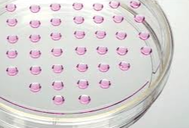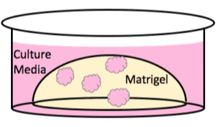BEATING CARDIOMYOCYTES CULTURED IN SEEDEZ
C. M. Didier, A. Kundu, J. T. Shoemaker, J. Vukasinovic and S. Rajaraman.
SeedEZTM Interdigitated Electrodes and Multifunctional Layered Biosensor Composites (MLBCs):
A Paradigm Shift in the Development of In Vitro BioMicrosystems.
Journal of Microelectromechanical Systems. 2020.
With permission.
DOI: 10.1109/JMEMS.2020.3003452 | https://ieeexplore.ieee.org/document/9126794
SeedEZTM Interdigitated Electrodes and Multifunctional Layered Biosensor Composites (MLBCs):
A Paradigm Shift in the Development of In Vitro BioMicrosystems.
Journal of Microelectromechanical Systems. 2020.
With permission.
DOI: 10.1109/JMEMS.2020.3003452 | https://ieeexplore.ieee.org/document/9126794
In the last decade, three dimensional (3D) cell culture has become an increasingly popular research tool used in labs worldwide. When grown in three dimensions, cells are no longer restricted to growing within a monolayer, and can begin to adhere to each other and the extracellular matrix, mimicking the native microenvironment from which the cells originated. The architecture of our SeedEZ scaffold allows cells to revert to their natural morphology. The advantages to 3D cell culture are expansive, allowing cells to express physiological proportions and localization of receptors, and respond to stimuli in the way that is naturally observed.
Standard 2D plating method, using a Petri dish or a multi-well plate, is still the most common practice for culturing cell lines. When using the canonical 2D method, we see an unnatural morphology in cells. The cells are flat and adhered to the rigid plastic surface. The 2D method results in altered cell cytoskeleton and produces a monolayer of cells without the same cell-cell communication or morphology seen biologically.
We are excited to be a part of this new front.
Thank you for your trust and confidence in the data discovered using our systems.
OUR UNIQUE 3D CELL CULTURE PRODUCTS
Other culture solutions
|
Method: 2D Culture
Limitations:
|
Method: 3D Spheroid
Limitations:
|
Method: ECM Co-Culture
Limitations:
|
Method: Organ-on-a-Chip
Limitations:
|








